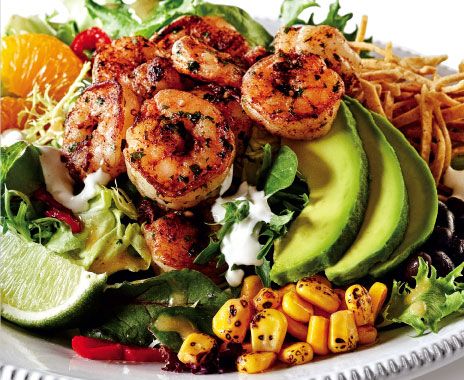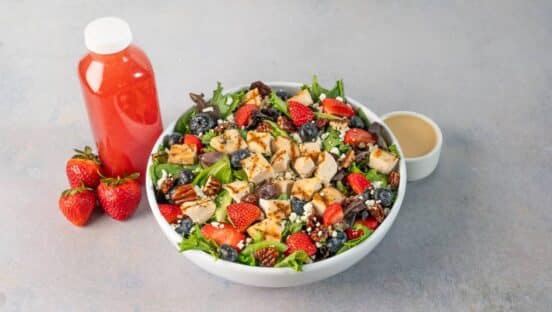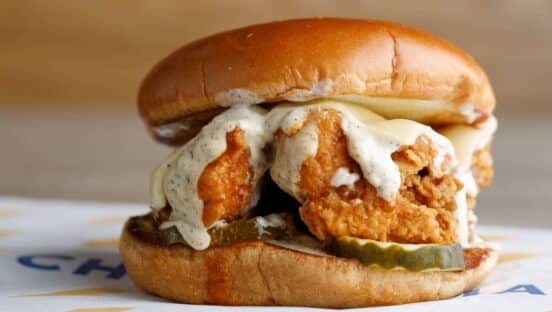Lighter menu offerings at restaurants long ago moved from being a nice option for health-conscious customers to being the expectation of a sizeable chunk of the population. Increased consumer demand for more nutritious dining choices has sparked an industry-wide movement toward health-focused menu development.
“If restaurants don’t have healthier choices, they are starting to miss out,” says Anita Jones-Mueller, chief operating officer of Healthy Dining. The company operates Healthy Dining Finder, an online database of restaurants and menu items to help people make healthy choices.
But while some brands have confined their healthy food development to whatever has a low calorie count, many quick-service and fast-casual restaurant menus are leveraging innovation and the use of fresher, higher-quality ingredients to stake a claim in the health movement.
Healthy Dining Finder’s main criteria for the food it recognizes are that they be rich in fruits, vegetables, lean proteins, whole grains, and unsaturated fats. “It’s super important to understand that it’s the value of the calorie, the nutrient density of the calorie” that matters most, Jones-Mueller says.
She says some limited-service brands recognized by Healthy Dining Finder, like Schlotzsky’s and Zoës Kitchen, have demonstrated creativity and artistry in providing healthy menu choices for customers. For example, the Chicken & Pesto Sandwich at Schlotzsky’s uses pesto, an unsaturated fat that is rich in flavor, instead of butter and mayonnaise, which contain saturated fat. The sandwich is made with chicken breast, lettuce, tomatoes, and basil pesto on a toasted sourdough bun. Guacamole is used in the same way in the restaurant’s Turkey & Guacamole Sandwich. Flavorful guacamole made with avocados—a fruit that has nutrient-rich, healthy fat—stands in for mayonnaise.
Zoës Kitchen, meanwhile, adds a nutritious whole-grain boost to its Quinoa Salad. The popular menu item mixes quinoa into a fresh lettuce mix with tomatoes and olives, which contain a healthy fat, as well as Feta for flavor. It’s served with pita bread.
Many other limited-service brands are similarly getting creative with their healthy offerings. Healthy Dining has seen significant use and member increase in the last two years. “There’s a whole industry effort to provide healthy fare,” Jones-Mueller says. “We’re seeing amazing change in the restaurant industry as they apply brilliance in pleasing Americans with tantalizing dishes.”
Maeve Webster, managing director for Datassential, a national restaurant research firm, says the industry doesn’t get enough credit for its move toward healthy menu items.
“People don’t understand exactly how much is going on in the industry,” she says. “It’s doing quite a bit to make menus healthy.”
Operators are taking a lot of time and care with healthier items, Webster says. It used to be that a turkey burger, for example, was the answer to a healthy burger. But today’s turkey burger, she says, is more appealing, the result of more innovation with interesting dressings, sauces, cheeses, and buns, among other ingredients.
Produce is also increasingly finding its way onto menus, Webster says. “It’s a great look and it can increase nutrient quality, as well as perceived wellness,” she says. Vegetarian items, such as pastas, Asian-style bowls, and veggie-based burgers, are becoming so popular that Webster is now seeing them on menus without even being called out as vegetarian.
Two of the biggest trends in produce are local sourcing and the use of heirloom varietals. Kale, pumpkin, and butternut squash have exploded over the last couple of years, Webster says, while cruciferous vegetables like Brussels sprouts and mustard greens, which are both very nutrient dense, continue to grow consistently. People are more aware of things like the seasonality of berries or the limited availability of heirlooms, and they’re willing to wait for them, she says.
Slapfish, a Huntington Beach, California–based seafood fast-casual concept, uses farm-fresh fruits and vegetables grown in the local high school’s organic garden. Its menu revolves around fresh, sustainable fish; Webster says sustainable fish is another healthy trend that’s on “a lot of people’s radar.”
Andrew Gruel, chef and co-owner of Slapfish, is out to show people that serving products that are higher in flavor, texture, and nutrition quality is a sustainable business model. The fish served at Slapfish is sustainably caught, using what Gruel calls the “pole and troll” method. A single fishing pole is used to catch one fish, which is immediately caught and put into an ice slurry. “It establishes transparency, which I know has helped us develop a loyal following,” Gruel says.
More commercial fishing methods, which use long lines and big nets, catch large numbers of fish but also unintended bycatch. The fish also sit in the sun for long hours and are not always treated properly on the boat, which can cause bruising, says Joyce Nettleton, a specialist in seafood nutrition. Poor treatment compromises the nutrition and health benefits of fish.
Americans are becoming more familiar with the benefits of eating fish, which is making it increasingly popular, Nettleton says. “The advantages of eating seafood at least twice a week include the provision of healthier fats, including omega-3s, generally low fat content, and abundant other nutrients,” she says. Other nutrients include selenium, vitamin D in fatty fish like salmon, and vitamin B12. As a source of high-quality protein, she says, seafood is also easier to digest than many other animal proteins, an advantage among older and younger people.
Because he uses high-quality ingredients, which pack big flavor and nutrients, Gruel says he is able to prepare dishes simply, with as few as four to five ingredients. He introduced a new lighter menu early this year, mixing a couple light classics, such as a Caesar Salad with a fish or shrimp option, and a Wedge Salad made with blackened hake, vegetables, and a lemon herb sauce. The lighter menu also has a few surprises, like the Banh Mi Burrito made with white fish, jalapeño, cucumber, carrot, and peppers, as well as a couple classic seafood-shack options: the Hot Shrimp Roll and the Grilled Fish & Chips, served with house-cut fries and slaw.
With the latter, a healthier alternative to classic fish and chips—also on the Slapfish menu—the fish is processed in-house, dusted in seasoning, and grilled. But Gruel says the traditional fish and chips is also healthier because the brand filters its oil multiple times per day. “Old oil is one of the things that makes it bad,” he says.
Fried fish is at the core of classic fish tacos, like those served at Rubio’s, the San Diego–based chain with 193 units. But cofounder Ralph Rubio says the company recently rolled out a new brand strategy that would have it offering more grilled fish options and fresh ingredients while building off the company’s heritage. Rubio calls the updated concept “lighter, brighter, and fresher.”
[pagebreak]
“Our mission is to offer healthy options without compromising flavor,” he says.
Rubio’s timing is right, Nettleton says. “Recent research by the Alaska Seafood Marketing Institute indicates that consumers are eating and asking for more seafood at chain and fast-service restaurants, and they want it in a healthier preparation,” she says. Those consumers prefer grilled seafood rather than fried for both taste and health reasons, she adds.
Rubio’s now offers black beans and a new citrus rice—white rice with lemongrass and citrus—that Rubio says pairs better with grilled fish. The brand also has the traditional pinto beans and Mexican rice. The new Ancho Shrimp Burrito and the updated recipe for its biggest seller, the Burrito Especial, feature the black-beans-and-citrus-rice combination. They’re also made with guacamole instead of cheese, opting for what Rubio describes as a fatty, creamy texture that’s fresher and better for consumers than cheese. “We didn’t compromise on flavor at all,” he says. “The new version is just a different experience, one I prefer.”
Carnitas is no longer on the Rubio’s menu because it doesn’t align with the new mission. The focus is more on grilled seafood and chicken, which are leaner proteins, as well as steak. More menu items will be available with the choice of grilled seafood this summer, including salads.
“Nobody is doing grilled seafood salad in a big way,” Rubio says. He intends to lead the way with offerings like the Chipotle Orange Salad, made with mandarin oranges, fire-roasted corn, fresno chilies, avocado, black beans, tortilla strips, and crema, with a chipotle orange vinaigrette dressing.
Using fresh, high-quality ingredients is the foundation of the “Food Mission” at Moe’s Southwest Grill, the Atlanta-based chain with 538 units in 37 states. In addition to the more than 20 fresh ingredients prepared in-house daily, Moe’s “Food Mission” revolves around items that are all natural, grass fed, certified organic, and contain no added hormones or preservatives. This focus on high-quality ingredients is a “big resonance for guests. They’re paying attention to what goes into their bodies,” says Pat Peterson, Moe’s executive chef.
Eating healthy may resonate, but eating flavorfully wins, he says. “A better ingredient will have more flavor to it,” Peterson says. Choosing a “better” ingredient, he adds, may be as simple as choosing romaine lettuce over iceberg.
It’s not always that simple to create good-tasting, healthy dishes, however. Lowering sodium can be a challenge, Peterson says, because you have to get creative to find replacements that continue to offer full flavor. Turning to spices and adding lime juice to Moe’s pico de gallo adds enough natural flavors so salt isn’t needed, he says.
The Homewrecker burrito is a good representation of Moe’s brand from a health standpoint, Peterson says. Not only is it filled with lots of nutrient-dense ingredients like all-natural chicken breast, beans, handmade guacamole, and pico de gallo, but it can also be customized however the guest prefers. Made without the tortilla, it becomes a bowl with fewer carbs. Guests can also order a junior size for a scaled-down version.
“We’re proud to offer a little better than par in the things we’ve taken the time to look at from a taste and nutrition angle,” Peterson says.
Of course, low fat, low carb, high protein, and vegetarian are just a few of the ways people define healthy eating for themselves. Pauli’s North End Restaurant in Boston, which specializes in subs and sandwiches, created a new breakfast menu to meet its guests’ specific dietary needs. Whether they follow a Paleo, gluten-free, Zone, vegetarian, Big Breakfast, or low-fat diet, customers can find anything they need on Pauli’s breakfast menu.
“Although breakfast items were already on my menu, I wanted to be able to provide those who wanted a healthy on-the-go breakfast an option,” says owner Paul Barker.
The Northender Wrap packs bacon, potatoes, and cheese in proportion to the Zone Diet’s 40 percent carbs, 30 percent protein, and 30 percent fat restrictions. For those following the Paleo diet of no processed foods, dairy, or grains, Pauli’s created a Western Omelet made with peppers, onions, a choice of chicken or steak, and three eggs.
Breakfast items are available all day, and substitutions such as egg whites or switching from a bagel to a wrap may be made. The reception has been overwhelming, Barker says. “You can tell people really needed this option,” he says. “There is nothing better than when a customer walks up to me and thanks me for providing them a breakfast that fits their lifestyle.”











